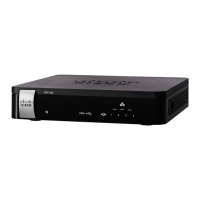Configuring Wireless Networks
Wireless Security
Cisco RV130/RV130W Wireless Multifunction VPN Router Administration Guide 60
4
Hackers know these default values and may try to use them to access your
wireless device and change your network settings. To prevent unauthorized
access, customize the device password so that it is difficult to guess.
• Enable MAC address filtering.
Cisco routers and gateways give you the ability to enable MAC address
filtering. The MAC address is a unique series of numbers and letters
assigned to every networking device.
With MAC address filtering enabled, wireless network access is provided
solely for wireless devices with specific MAC addresses. For example, you
can specify the MAC address of each computer in your network so that
only those computers can access your wireless network.
• Enable encryption.
Encryption protects data transmitted over a wireless network. Wi-Fi
Protected Access (WPA/WPA2) and Wired Equivalency Privacy (WEP) offer
different levels of security for wireless communication. Currently, devices
that are Wi-Fi certified are required to support WPA2, but are not required
to support WEP.
A network encrypted with WPA/WPA2 is more secure than a network
encrypted with WEP, because WPA/WPA2 uses dynamic key encryption.
To protect the information as it passes over the airwaves, enable the highest
level of encryption supported by your network equipment.
WEP is an older encryption standard and may be the only option available
on some older devices that do not support WPA.
• Keep wireless routers, access points, or gateways away from exterior walls
and windows.
• Turn wireless routers, access points, or gateways off when they are not
being used (at night, during vacations).
• Use strong passphrases that are at least eight characters in length.
Combine letters and numbers to avoid using standard words that can be
found in the dictionary.

